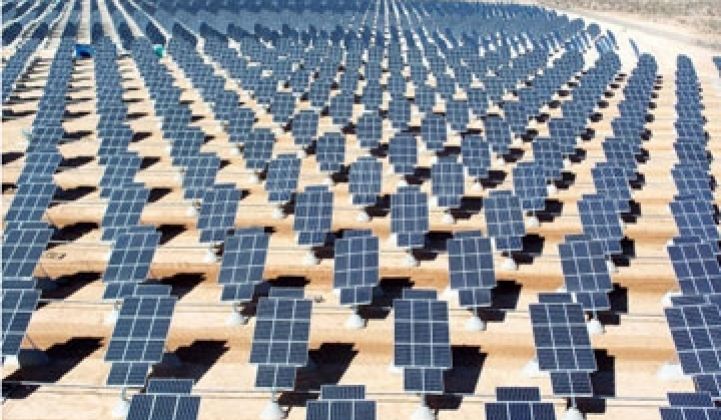SunPower has built a reputation as a maker of highly efficient solar panels, and charges a premium price for them. The strategy has worked, particularly in the markets where customers want to get the most solar power out of their limited residential or commercial rooftop space.
But the company is facing pressure to cut its prices, especially during a steep economic downturn when supply has exceeded demand, and many of its competitors are eager to tout their lower-price panels.
"SunPower still has a great business model. But in this environment, when demand is dropping, selling premium products at premium prices could cause them to lose market share unless they cut prices, which would cut into their margins," said Brian Fan, senior director of research at Cleantech Group, a market research firm in San Francisco.
Analysts have been questioning how competitive SunPower could remain in the short term if it doesn't cut its prices more substantially (see SunPower's Quarterly Profit Shot Up Five-Fold). The recession has turned more consumers into bargain hunters. The same is probably true for utilities, which can take advantage of the fact that solar panel makers have built lots of factory capacities but can't make full use of them.
SunPower just delivered disappointing first-quarter results. The company posted a net income loss of $4.8 million, compared with a net income of $31.4 million from the fourth quarter and $12 million from the first quarter of 2008 (see SunPower Posts Q1 Net Loss, Delays Factory Plans). Company executives cited the recession, long winter in Europe and sluggish demand in the U.S. market among reasons for the lackluster performance.
"Supply clearly exceeded the pace of solar system deployments in the first quarter," said SunPower CEO Tom Werner when he discussed the earnings last Thursday with financial analysts. As a result, SunPower is scaling back its manufacturing plans.
San Jose, Calif.-based SunPower understands the pricing pressure, but its management maintains that its model still works. In fact, Werner emphasized a few times that the company's products outperform competitors, so it makes sense to charge more. He noted that the company remained strong in the residential and small-business (less than 10-kilowatt systems) markets in California, a leader in solar energy deployment.
He then pointed out that SunPower cut average selling prices of its components by less than 10 percent. The components business sells panels, trackers and inverters, and he didn't provide details on the panel pricing.
"Our view is a more rapid price decrease in Q1 would not necessary have resulted in a meaningfully higher shipping volume within the quarter," Werner said. "In this environment the correct course was to maintain SunPower's premium pricing position."
SunPower is selling its panels at around $3.70 per watt while its peers average $2.50 to $2.60 per watt, Fan said. Mark Bachman, a senior equity analyst at Pacific Crest Securities, said his survey of installers showed that the installers are charging their customers on average $3.60 per watt for commercial systems using SunPower panels and $4.20 per watt for residential systems.
The company, which also builds power projects for businesses and utilities, makes solar cells that can convert 22 percent of sunlight into electricity. Those are the most efficient crystalline silicon solar cells on the market today, and most of the solar panels sold worldwide are made with crystalline silicon cells.
Some of its competitors are catching up, however. China-based Suntech Power recently launched a new production process that has boosted its silicon cells to close to 19 percent efficiency (see Pluto: Suntech's Shot at Technical Glory). Suntech has followed SunPower's sales strategy by creating a dealer network and entering the power project development business.
"We think SunPower could cut prices further to remain competitive with lower-cost producers such as Suntech," Bachman wrote in a research note last week.
SunPower is aggressively pursuing opportunities to build power plants for utilities. In fact, Werner said the company "is most competitive in the utility segment." It just announced a deal to supply up to 600 megawatts worth of panels to the FPL Group, which owns utility Florida Power & Light and power producer NextEra Energy. SunPower also is building two power plants totaling 35 megawatts in capacity for Florida Power & Light. San Francisco-based Pacific Gas and Electric Co. has agreed to buy power from a 250-megawatt power plant to be built and operated by SunPower.
While Werner maintains that his company offers exceptional products to utilities, he's up against competitors who claim that they can offer great discounts.
Tempe, Ariz.-based First Solar just won a second contract to build a power plant for Sempra Generation (see First Solar to Build 48MW Power Plant for Sempra). It also bought more than 1-gigawatt worth of unfinished projects from OptiSolar, and those include a 550-megawatt project for delivering power to PG&E.
First Solar's cadmium-telluride panels aren't nearly as efficient as SunPower's, but First Solar says it can build them far cheaper than just about anyone else (see First Solar Cuts Production Cost to $0.98 Per Watt).
At an industry conference last week, Sempra CEO Michael Allman said the company picked First Solar because it could deliver low-cost panels (see Sempra Wants 300MW Plus of Solar In Arizona). Sempra develops, owns and operates power plants and sells electricity to utilities.
"There is a tremendous pressure to deliver the lowest cost solar power," Allman said.



